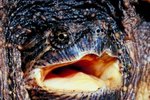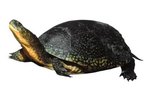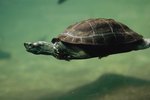
Turtles are long-lived creatures who in captivity or otherwise are susceptible to nutritional deficiencies and diet-related health problems; feeding is one of the most important aspects of their husbandry. The natural diet of turtles varies by species, age and sometimes gender. Hatchling yellow-bellied slider turtles need a varied diet of insects, fish and plant material.
Yellow Bellied Biology
Yellow-bellied slider turtles (Trachemys scripta scripta) are native to the southeastern United States, where they inhabit lakes, rivers, ponds and man-made canals. They are dietary generalists that consume insects, fish, amphibians, aquatic vegetation, algae and carrion. Despite their dietary flexibility, yellow-bellied sliders exhibit age-related shift in food habits; while young turtles are largely carnivorous, adults primarily consume plant material.
General Feeding Procedures
Yellow-bellied sliders eat in the water. When providing food, drop a few items into the water near the turtles. Healthy turtles will usually swim right over and immediately begin eating. Don’t saturate the tank with food items; provide only as much food as your turtles will consume within five to 10 minutes. Young turtles should be fed at least once per day, but if it is feasible, two meals will encourage faster growth.
Insects
Insects -- especially aquatic larval stages -- are an important part of the diet of yellow-bellied sliders in the wild, and they should form a high percentage of your pet’s diet as well. You can feed your pet crickets, mealworms, super-worms or roaches, and it is a good idea to rotate them to provide a more varied diet.
Fish
Fish are an excellent dietary component for turtles, though some turtles may have trouble catching them. The turtles will usually catch slow swimming species, but frozen-thawed or freshly killed fish allow the young turtles to catch their dinner easily. While live fish do provide supplemental exercise and stimulation, they can spread parasites and disease to your turtles; obtain live feeders only from reputable sources.
Fruits and Vegetables
It is good practice to get your young turtle accustomed to eating plant material; older turtles who refuse vegetables and consume a completely protein-based diet may develop health problems. Offer your pet small pieces of strawberries, blueberries, collard greens or squash. Prevent spoiling the water quality by removing any uneaten fruit or vegetables after 12 to 24 hours.
Commercial Foods
Many commercial foods are available for pet turtle owners. While commercial turtle pellets can be a quality component of your yellow-bellied turtle's diet, they should not form the entire diet. The mess that commercial pellets cause partially offsets the convenience of these products. When a turtle bites into a pellet, numerous particles are released into the water. Counteract this by selecting the smallest pellet size that is practical.
References
Resources
Photo Credits
-
Zedcor Wholly Owned/PhotoObjects.net/Getty Images



